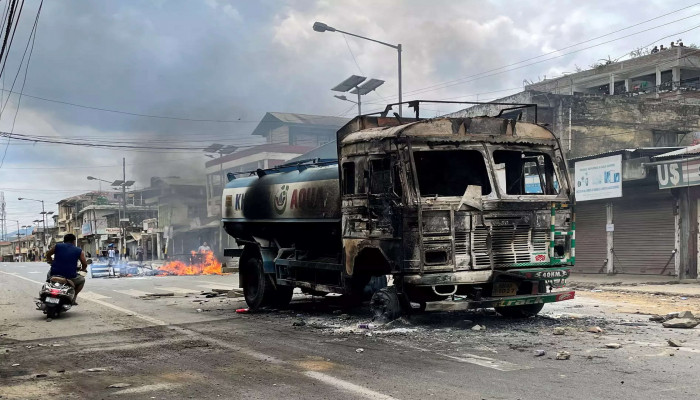A Raging Saga of Violence in Manipur
- In Current Affairs
- 11:04 PM, May 11, 2023
- Ankita Dutta
The violence that has been going on in Manipur for some days now between the Imphal Valley-based Hindu Meiteis (also referred to as Manipuris) and the hill-based Kukis, who are predominantly Christian, has made headlines almost everywhere. Besides the imposition of shoot-at-sight orders by the Government, the Army has also been deployed to bring the situation under control. It was from the Kuki-dominated border district of Churachandpur that the violence began on the 27th of April and later spread to various other districts including Imphal West, Kakching, Thoubal, Jiribam, and Bishnupur. The ongoing tension in Manipur is primarily between the Hindu Meitei community and the Christian Kukis.
As per the latest information, several houses of the Tamil Hindu community residing in the Indo-Myanmar border town of Moreh have been burnt down by radical Christian groups. This community has made Manipur their home and is very well-integrated with the Manipuri Hindu society and its culture. On the other hand, the Hindu Meities of Manipur largely belong to the Gaudiya Vaishnava Sampraday. It was Sri Sri Bhubaneswar Sadhu Thakur, a Bishnupriya Manipuri Vaishnavite Guru who not only popularised the worship of Krishna among the Meities but also established the Sri Radha Govinda Ji temple or Govindabari at Nabadweep in West Bengal.
In fact, the Bishnupriya Manipuri community regarded the Meitei Hindus as closer to them culturally than people from the hills who had expelled the Bishnupriyas from their own homeland. They are now residing in several areas of Assam’s Barak Valley and a few districts of Upper Assam and almost all of these Bishnupriya Manipuri families are staunch practising Hindus. Earlier, many Nagas and Kukis too, used to assimilate themselves into the larger Meitei identity and become Hindus themselves. But this is no more the case. In the face of all these, can we still deny the reality by arguing that it is an ‘ethnic’ conflict or an ‘inter-tribal’ feud in Manipur?
So, defying all political correctness, let the truth be accepted that it is a Hindu-Christian conflict that the rest of Bharat is witnessing again now at its Poorvottar frontier. It is again a battle of civilisational existence that the Hindus of the Northeast are fighting for. Inter and intra-tribal hostilities certainly cannot be ruled out, but at the same time, we also cannot overlook the religious dimension of the problem of insurgency in the Northeast that has been raging for many years now. The same holds true for Manipur as well. The decades-old religious faultlines between the Hindus and the Christians have reopened again, especially with respect to the issue of the inclusion of the Meiteis in the Scheduled Tribes category.
This is what agitated the Christian organisations of Manipur the most, compelling us to raise some very important questions in this regard – Who really must be recognised as the STs in the North-East? Can the Christians be termed as a ‘minority community’ here? In other words, who are the real minorities in the Northeast? In the context of Manipur, economic backwardness doesn’t seem too good an argument as there are several areas in the valley that are poorer than the hills. The Government needs to take into account all these multi-faceted aspects of the problem before implementing any policy concerning any community.
Hindu-Christian Conflicts in the North-East
Every community in the Northeast is riddled with insecurities about the other. This trend becomes more visible when the conflict is directly between the Hindus versus the Christians. Historically speaking, the Kukis have been the main perpetrators of several conflicts in Manipur earlier as well. Ethnic cleansing of the Nagas and the Tamil Hindus from Moreh in the year 1995 was a pre-planned agenda of the Kukis, all with the objective of increasing their presence in the area, both socio-politically and culturally. As written by Ranabir Samaddar in his book Refugees and the State: Practices of Asylum and Care in India, after the fierce Kuki-Naga feuds of the early 1990s, the Kukis took over control of Moreh and forced the Nagas out.
The Nagas dominated many parts of the highway that connects Moreh with Imphal, but today there is hardly any Naga population left in Moreh. The Tamils of Moreh have been the victims of extortion at the hands of the Kuki militants belonging to the Kuki National Army (KNA). In 1995, the Kukis kidnapped a Tamil businessman from Moreh and held him in the nearby village of Chang Vangphei. The trader was eventually killed because the Tamils refused to pay the tax. This sparked off bloody riots between the Tamil Hindus and the Christian Kukis. But, the Kukis found that the Tamils, who were in possession of quite an array of arms for their personal safety, could not be so easily made to accept their demands.
So, peace prevailed and the KNA was compelled to cut down on their extortion-related activities in the Tamil-Hindu-dominated area of Moreh. In other parts of the Northeast too, the unabated immigration of the Kuki-Chins from Myanmar has led to the ethnic cleansing of several native communities from many areas. The Jampui Hills of Tripura are a very good example of this. The area has become Christian majority at present primarily because of illegal immigration, leading the original settlers, i.e. the Hindu Reangs, to move out to other safer Hindu-dominated locations. A Shiva temple situated at a place called Behling Shiv in the Jampui Hills was destroyed by Christian Mizo and Kuki groups in the year 1997.
Behling Shiv was renamed as Betlingchhip with the objective of whitewashing the rich Hindu heritage of this area and thereby re-write its history in due course of time. British records (specifically The Imperial Gazeteer of India: Volume IV by William Winson Hunter) have clearly mentioned the name of this place as Betling Sib. Sibraikhong, the highest mountain peak of Tripura, derives its name from Sibrai – the highest Devata of the Reangs equated with Shiva. After the destruction of the Shiva temple, Christians planted crosses in different areas of the sacred Jampui Hills area and also renamed the Sibraikhong peak as Thaidawr Tlang.
Although several local Hindu groups, with the support of organisations such as Bajrang Dal and Vishwa Hindu Parishad have attempted to rebuild the Shiva temple, fanatical Christian organisations have continuously opposed such a move by the Hindus. The immigration from Myanmar and the proselytisation activities of the Christian groups and organisations are all a part of the conspiracy of the Church to carve out a separate Zo nation for the Kuki-Chin community, aided by the Christian Mizos and the Zomis, along the border areas of Manipur, Mizoram, Nagaland, Arunachal Pradesh, and a few parts of Tripura.
In this context, we cannot overlook the exponential spike in the population of the Kukis from 1901 till 2022, along with a simultaneous decline of the population of the Nagas and the Meiteis. In 1901, the Kukis accounted for only 1% of the total population of Manipur, whereas the Meiteis and the Nagas constituted 60% and 16% of the population, respectively. Fast forward to 2022, the Meiteis and the Nagas constituted 49% and 15% of the state’s total population, respectively. On the contrary, the Kukis accounted for 29% of the population of the state. The population growth rate of the Kukis has registered a consistent increase; but, that of the Meiteis and the Nagas exhibit a relatively stable curve over the last 30 years.
As per the Census of 2011, the Kuki population in Manipur was 4,67,854 in terms of absolute numbers. But it is now estimated to be around 30% of the total population of Manipur, i.e. approximately 9 lakhs. However, projecting the Kuki population in the year 2022 using Manipur’s 2021 birth rate, i.e. 13.3, it comes to around 5.4 lakhs. Even a conservative estimation shows an unaccounted excess of 2-3 lakhs of the population of the Kukis. The cause of this abnormal spike in the Kuki population growth rate points towards an inorganic growth of their population through illegal immigration from across the border with Myanmar.
What is the Current Conflict All About?
To understand this, let us first begin by understanding the population composition of Manipur in brief. The three most important ethnic groups inhabiting present-day Manipur are the valley-based Hindu Meiteis and the Pangals (Manipuri Muslims); the hill-based, predominantly Christian Naga communities such as Kabui, Tangkhul, Khoirao, Maring, etc.; and, the Kukis who are relatively smaller in number, e.g. Thadou, Hmar, Vaiphei, Gangte, Simte, Zou, etc. The northern hills are predominantly populated by the Tangkhul Nagas, and the southern hills are the main bastion of the Chins, Kukis, Zomis, and Mizos. Many Tamils from Moreh have migrated elsewhere – to Tamil Nadu or outside of India.
So, the population in the hills of Manipur is largely Christian unlike that of the valley. But, the increasing popularity of Christianity in Manipur in the present times can be understood from the fact that it is today the second fastest-growing religion in the state, accounting for about 45% and more of the total population. Besides the Jaintias of Meghalaya and the Noctes and the Apatanis of the Ziro Valley of Arunachal Pradesh, the Meiteis of Manipur have been among those who have staunchly resisted the proselytisation agenda of the Church. Moreover, besides Assam and Tripura, Manipur, at present, is the only other state in the North-East where Hindu Dharma is still in existence.
But Christianity has been making inroads among a significant section of the Meiteis here since the early 2000s, mainly as a result of the proselytisation endeavours of the Naga and the Kuki pastors from the hills. This important angle must not be overlooked while we try to analyse and understand the linkages between the decline of Hindu Dharma in the North-East, eventually paving the way for an Abrahamic thought process to take root among the people here, and the subsequent rise of secessionist movements. Inter and intra-community rivalries (often referred to as ethnic or tribal conflicts) were quite commonplace in earlier times as well, before the advent of Christianity.
But, the rise of Christianity gave a new texture to these conflicts that now became intertwined with a separatist mindset informed by the logic of ‘Who is superior to whom’? This time, the violence began in Manipur when several Kuki organisations called for a 12-hour total shutdown in protest against the state Government's decision to carry out a survey on reserved and protected forest areas and wetlands under the ‘Green Manipur’ campaign. Largely inhabited by the Kuki community (including Kuki-Chin migrants from Myanmar), these areas are the hotspots of illegal poppy cultivation in Manipur. Interestingly, the timing of these protests coincided with the visit of Chief Minister N Biren Singh to Churachandpur.
It was on the 3rd of May that the All Tribal Students’ Union of Manipur (a predominantly Christian body comprising of various Naga and Kuki organisations) called for a Tribal Solidarity March in Churachandpur to oppose the demand for the inclusion of the Meiteis in the ST category. The protests were initially concentrated in the hill districts of Manipur, specifically Churachandpur, but soon began to take a violent turn. Hateful and provocative messages against the Meitei Hindus began to circulate in social media, which led to the suspension of mobile internet services for 5 days, the imposition of night curfew and Section 144 in several places of the state.
The same organizations which were a part of this protest also expressed their displeasure after the Government of Manipur had ordered the demolition of churches constructed on illegally-occupied lands in Imphal during an eviction drive in March 2023. In this regard, we also need to take note of certain important events that have been taking place in Manipur over the past few months, such as the resignation of a few MLAs, the NRC issue which is gradually picking up steam in the state, etc. Then came the directive of the Manipur High Court to the State Government for the setting up of a committee to consider the matter of including the Meiteis in the ST category.
The High Court, of course, does seem to understand the rationale behind this demand of the Meiteis. But in the protest rallies that were being carried out against this directive of the High Court, the protesters were seen raising hateful slogans against the Hindus of the Valley while carrying sophisticated arms and weapons such as AK-47s. Who provided them with these arms? Were common Kuki civilians assisted by militants in their war against the Meiteis? Just a few days before the occurrence of this violence, a banned militant outfit – the Kuki Independent Army (KIA) – led by its Commander-in-Chief, had looted a large number of arms and ammunition from a designated camp at Chongkhuzou village in Churachandpur.
The way things have panned out, we certainly cannot rule out the possibility of an outside hand in these protests. Shops owned by Hindu Meitei families were mercilessly looted and destroyed by armed Christian Kukis in different areas of Bishnupur and Churachandpur districts. The Christian Kuki outfits that led the protest movement also burnt down the houses and temples of the Hindu Meiteis. A violent Kuki mob vandalised and destroyed a temple of Eputhou Pakhangba and also burnt its Salai Taret flag at Thingam-phai Meetei Lekai in Churachandpur district, mainly in retaliation for the demolition of illegally-constructed Churches in the Imphal Valley by the Government.
The Hindus of the Valley have been forced to leave their homes to other safer Hindu-dominated areas like Moirang, Saiton, and Ningthoukon, besides the capital city of Imphal and the southern districts of Assam in the Barak Valley so as to escape the terror. The towns of Kumbi, Moirang, Ningthoukhong, and Kwakta are lodging thousands of displaced people who have been evacuated from Churachandpur and the adjoining settlements. We must not forget that most of the militant groups of the Northeast are sponsored both overtly and covertly by the Church. These groups are providing extensive help to the Kuki missionaries for constructing Churches at several strategic locations in the border areas of Manipur.
Their larger objective is that during crisis times such as these, the same Churches can be used as safe hide-outs for the militants. Hence, these militant groups can be seen to be at the forefront of suppressing at gunpoint any opposition by the Meitei Hindus against Christian conversions in the Valley area. Their long-term plan has always been to convert the Hindu land of Manipur into ‘Manipur for Christ’ along the lines of ‘Nagaland for Christ’ of the National Socialist Council of Nagaland (NSCN). Unfortunately, we do not yet see many media platforms covering these real issues. On the contrary, it has been seen that several Pakistani media houses are spreading fake news on the Manipur violence.
Churachandpur – the Militant Hotbed of Manipur
The protests began from the largest district of Manipur, i.e. Churachandpur – the epicentre of all terrorism and terror activities in the state, from rapes and molestation to the killing of Indian army officers and the bombing of military convoys. A shocking incident of rape and molestation of around 25-26 women from the Hmar community brought the district to the national limelight in the year 2006. The perpetrators were the militants of a Christian insurgent outfit. Each of Manipur’s nine districts has been affected, in some way or the other, by unending militant violence. But, the pattern of violence that has been witnessed in the hill district of Churachandpur over the years has been the most convoluted of all.
Firstly, because of the population composition of this district which is spread across several rival factions of the Christian Nagas and the majority Kukis; second, Churachandpur shares its borders with Assam, Mizoram, and Myanmar. The hilly terrain of Churachandpur is surrounded by thick and dense jungles along the unfenced and densely forested border with Myanmar. There are several vulnerable portions of the India-Myanmar border in this strategically-located district that have been facilitating the entry of insurgents and other anti-national elements into the state time and again, especially during conflicts such as the one at present and other volatile times.
The rapid spread of Christianity in Churachandpur was subsequently followed by bitter community conflicts and hostilities between the Kukis and the Nagas since the beginning of the 1990s. In 1997, clashes broke out between the Kukis and the Zomis, resulting in an undocumented number of fatalities and large-scale internal displacement of the population. In due course of time, several militant groups, each claiming to represent specific groups and communities, and more often than not, multiple outfits claiming to represent the same community came up in the state. Significantly, almost all of them have a viable presence in the Christian-dominated hill districts, especially Churachandpur.
Churachandpur offers an easy route to Myanmar compared to the other border districts of Manipur. There is a village called Behiang in Churachandpur, where Col. Viplav Tripathi, along with his wife and minor son were killed by militants in November 2021. The road from Churachandpur town to Behiang falls under the area of influence of the Zomi Revolutionary Army – an insurgent organisation having well-established links with drugs and narcotics syndicates in Nagaland and Myanmar. Behiang is among the three listed drug trafficking routes, more precisely known for the smuggling of heroin and Yaba tablets from the Wa state of Myanmar into Manipur for onward supply into the rest of India and abroad.
The Hill-Valley Divide in Manipur
Prior to the Partition of Bharat in 1947, the king of Manipur had promulgated two laws for ensuring the smooth administration of the Imphal Valley and the hill districts. One was the Manipur State Constitution Act for people of the valley and the other was the Manipur State Hill (Administration) Regulation for the hill residents. This was where and how the difference in the administrative set-up of both these regions of the state began, and it continued to be operational even after Manipur joined the Union of India in the year 1972. When Manipur was a Union Territory prior to this, the Government body of the hill areas was known as the Standing Committee.
But, with the promulgation of the above-mentioned two laws, those living in the plains could no longer buy land in the hill areas. After Manipur gained statehood, the Standing Committee of the Hills was renamed as the Hill Areas Committee (HAC), entrusted with the responsibility of safeguarding the interests of the hill residents of the state. The root of the problem lies in the fact that the current administrative system provides administrative autonomy to the elected Hill Areas Committee. So, the hill residents of Manipur (largely Christian) have their own share of freedom everywhere in the state with respect to land and resources, unlike the Hindus of the Valley.
The issue of uncontrolled immigration to Manipur, and especially the Imphal Valley, in search of cultivable land and easy money, by people from across the border with Myanmar and Bangladesh, is rarely talked about. This has compounded the problem further in recent times. Deforestation, illegal poppy cultivation, and smuggling of drugs and narcotic substances are some of the problems associated especially with the Kuki-Chin immigrants from Myanmar. The hill areas of Manipur inhabited by the Christian Nagas and the Kukis are protected as “tribal lands” via laws that strictly prohibit outsiders, including the Meitei Hindus of the Imphal Valley from settling there.
What if the Meiteis are Recognised as STs?
So, if included in the ST list, the Meiteis will be able to purchase land in the hill areas of Manipur, inhabited by the Christian groups. At present, the Meiteis cannot buy land in almost 90% of the state’s territory. The reverse is however possible. That means, the Christians can come and settle in the Valley at any time and also buy land. This has created a huge imbalance, a gap between the rights and freedoms of the Hindus in their own land versus those of the Christians. So, in that sense, are the Hindus of Manipur protected? No. They are not. Is their population increasing? No. Not really. From the demographic perspective, the population of Hindus in Manipur is declining almost every decade.
Although the Hindus comprise 42-45% of the total population of Manipur at present, they reside in a very small area of the state, i.e. hardly 10%. The Pangals or Manipuri Muslims comprise around 10% of the state’s total population. However, the population of Muslims is gradually on the rise in Manipur because of the infiltration of Bangladeshi immigrants from neighbouring Assam. The hills comprise more than 85% of the total area of the state, but here, only 40-42% of the non-Hindu population resides. The starkly visible religious demographic imbalance of Manipur becomes clearer when we have a glance at the figures of the Census beginning from 1901.
In 1901, the population of Hindus in Manipur was 96%, which had fallen to 64% by the year 1949. Hence, there has been a drastic decline in the percentage of the population of Hindus in Manipur over a period of time. As per the Census data of 2011, Hindus comprised 41.39% of the total population of the state, far below 50%. Looking at these trends, it can be safely assumed that in the forthcoming years as well, the Hindu population of Manipur is all set to decline. While the population of other religious communities, i.e., Muslims and Christians, is continually on the rise. The same story happened in the other hill states of the Northeast as well, whether it be in Mizoram, Nagaland, or Meghalaya.
Way Forward
It remains to be seen how the current BJP Government at both the Centre and the state tackles these issues, considering the fact that the BJP also cannot afford to antagonise its Christian vote bank in the Northeast. The Assembly elections in Mizoram are due later this year and the Christian Maras constitute a significant support base of the BJP, crucial for winning the elections. Moreover, in a state like Manipur which has been a witness to deep religious strife for decades among the Meiteis, the Nagas, and the Kukis, any gains for one community are seen to be at the cost of the other. The Government must therefore tread very carefully so that the rule of law is restored and the wounds among these communities are gradually healed.
Acknowledgement: A sincere note of thanks to Babeena and Jayalakshmi from Manipur for enlightening me on the several complex dimensions of this conflict. Thanks to Dipak Singha Ji as well for reposing faith in me.
Image source: The Economic Times
Disclaimer: The opinions expressed within this article are the personal opinions of the author. MyIndMakers is not responsible for the accuracy, completeness, suitability, or validity of any information on this article. All information is provided on an as-is basis. The information, facts or opinions appearing in the article do not reflect the views of MyindMakers and it does not assume any responsibility or liability for the same.







Comments